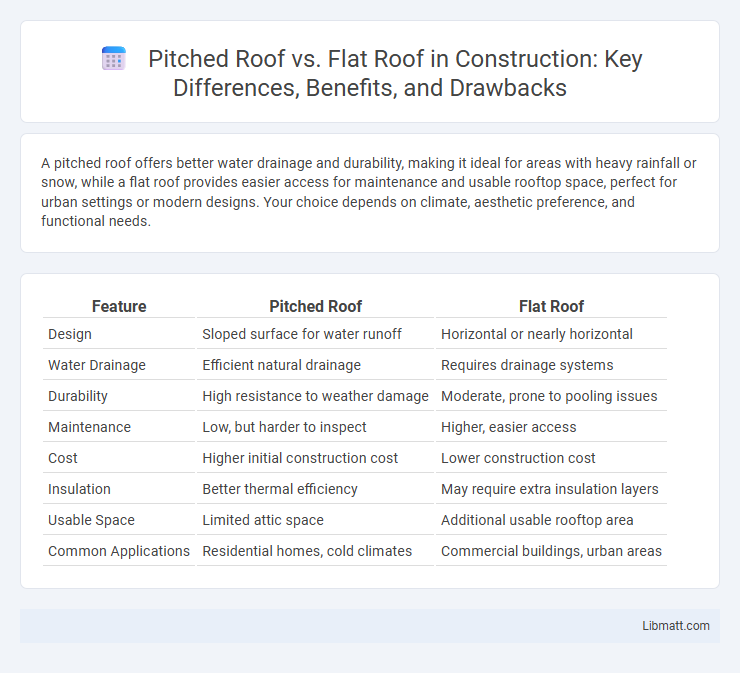A pitched roof offers better water drainage and durability, making it ideal for areas with heavy rainfall or snow, while a flat roof provides easier access for maintenance and usable rooftop space, perfect for urban settings or modern designs. Your choice depends on climate, aesthetic preference, and functional needs.
Table of Comparison
| Feature | Pitched Roof | Flat Roof |
|---|---|---|
| Design | Sloped surface for water runoff | Horizontal or nearly horizontal |
| Water Drainage | Efficient natural drainage | Requires drainage systems |
| Durability | High resistance to weather damage | Moderate, prone to pooling issues |
| Maintenance | Low, but harder to inspect | Higher, easier access |
| Cost | Higher initial construction cost | Lower construction cost |
| Insulation | Better thermal efficiency | May require extra insulation layers |
| Usable Space | Limited attic space | Additional usable rooftop area |
| Common Applications | Residential homes, cold climates | Commercial buildings, urban areas |
Introduction to Pitched and Flat Roofs
Pitched roofs feature a sloping design that efficiently directs water and snow away, making them ideal for areas with heavy rainfall or snowfall. Flat roofs, with their minimal slope, provide modern aesthetics and easier access for maintenance but require advanced waterproofing systems to prevent leaks. Your choice between these roof types should consider factors like climate, building style, and maintenance preferences to ensure optimal durability and performance.
Design and Aesthetic Differences
Pitched roofs feature sloping surfaces that create a classic, dynamic appearance and enhance water runoff, making them ideal for varied climates. Flat roofs present a modern, minimalist aesthetic with a horizontal profile that maximizes usable rooftop space for gardens, terraces, or solar panels. The choice between these designs significantly influences a building's architectural style, curb appeal, and functional outdoor area potential.
Cost Comparison: Pitched vs Flat Roof
Pitched roofs generally have higher initial installation costs due to more complex framing and materials, while flat roofs tend to be more affordable upfront with simpler construction. Maintenance expenses for flat roofs can be higher over time because of drainage issues and increased susceptibility to leaks, whereas pitched roofs offer better water runoff and durability. Long-term cost efficiency of pitched roofs often offsets higher initial costs compared to flat roofs, which may require more frequent repairs and replacements.
Installation Process and Complexity
The installation process of pitched roofs involves constructing a sloped framework with rafters and trusses, which requires precise measurements and skilled labor to ensure proper alignment and waterproofing. Flat roofs demand careful layering of waterproof membranes and insulation on a level surface, often involving complex drainage solutions to prevent water pooling. The complexity of pitched roof installation generally exceeds flat roofs due to structural framing intricacies and steep angles, impacting labor time and costs.
Durability and Lifespan
Pitched roofs, typically made with materials like asphalt shingles, metal, or clay tiles, offer enhanced durability and can last 20 to 50 years depending on the material and maintenance. Flat roofs, often constructed with materials such as EPDM rubber, TPO, or modified bitumen, generally have a shorter lifespan ranging from 10 to 25 years and require more frequent maintenance to prevent leaks and water damage. The steep slope of pitched roofs facilitates better water runoff, reducing the risk of water pooling and extending roof longevity compared to flat roofs.
Maintenance Requirements
Pitched roofs generally require less frequent maintenance due to their efficient water runoff, which minimizes the risk of leaks and water damage. Flat roofs demand more regular inspections and upkeep to address potential issues such as ponding water, membrane cracking, or debris accumulation. Proper maintenance of flat roofs often includes ensuring effective drainage systems and timely repair of surface materials to extend roof lifespan.
Energy Efficiency and Insulation
Pitched roofs offer superior energy efficiency due to their natural ventilation and the ability to accommodate thicker insulation layers within the roof structure, reducing heat loss and improving thermal performance. Flat roofs can be optimized for insulation by using high-performance materials such as rigid foam boards and reflective coatings to minimize heat gain and loss, though they may require more maintenance to maintain energy efficiency. Your choice between pitched and flat roofs should consider the local climate and insulation techniques to maximize energy savings and comfort.
Weather Resistance and Drainage
Pitched roofs excel in weather resistance due to their steep slope, which allows efficient water runoff and prevents pooling, reducing the risk of leaks and water damage. Flat roofs require advanced waterproofing systems and well-designed drainage solutions, such as internal drains or scuppers, to manage water accumulation and avoid structural issues. Your choice between pitched and flat roofs should consider local climate conditions, particularly rainfall intensity and snow load.
Space Utilization and Attic Potential
A pitched roof maximizes space utilization by creating an attic that can be converted into additional living or storage areas, enhancing your home's functionality. Flat roofs offer minimal attic space but provide usable rooftop areas for terraces, gardens, or solar panel installations. Choosing between the two depends on your priorities for attic potential versus practical rooftop use.
Choosing the Right Roof for Your Home
Choosing the right roof for your home depends on factors like climate, aesthetics, and maintenance requirements. Pitched roofs offer superior water drainage and increased attic space, ideal for rainy or snowy regions, while flat roofs provide a modern look with easier access for maintenance and rooftop usage. Assessing local weather conditions, architectural style, and long-term costs ensures a roofing choice that balances durability, energy efficiency, and budget.
Pitched roof vs flat roof Infographic

 libmatt.com
libmatt.com